Seat Alhambra 2012 Owner's Guide
Manufacturer: SEAT, Model Year: 2012, Model line: Alhambra, Model: Seat Alhambra 2012Pages: 388, PDF Size: 6.72 MB
Page 21 of 388

19
Seat belts
Why wear seat belts? Frontal collisions and the laws of physics
Fig. 5 Vehicle about to
hit a wall: the occupants
are not wearing seat
belts.
Fig. 6 The vehicle hits
the wall: the occupants
are not wearing seat
belts. It is easy to explain how the laws of physics work in the case of a head-on
collision: when a vehicle starts moving
⇒ fig. 5, this is a certain amount of
energy known as kinetic energy both in the vehicle and in the occupants.
The higher the speed and the greater the weight of the vehicle, the more
energy there is to be absorbed in an accident.
The most significant factor, however, is the speed of the vehicle. If the
speed doubles from 25 km/h to 50 km/h, for example, the kinetic energy is
multiplied by four.
The amount of kinetic energy depends on the speed of the vehicle and the
weight of the vehicle and its passengers. The higher the speed and the
greater the weight of the vehicle and the occupants, the more energy there
is to be absorbed in an accident.
Passengers not wearing seat belts are not “attached” to the vehicle. As a
result, in a frontal collision they will continue to move forward at the speed
their vehicle was travelling just before the impact until something stops
them! Because the passengers in our example are not restrained by seat
belts, all of the passengers' kinetic energy has to be absorbed at the point
of impact ⇒ fig. 6.
At speeds of 30 km/h to 50 km/h, the forces acting on bodies in a collision
can easily exceed one tonne (1000 kg). At greater speed these forces are
even higher.
This example applies not only to head-on collisions, but to all accidents and
collisions.
Safety FirstOperating instructionsPractical tipsTechnical Specifications
Page 22 of 388
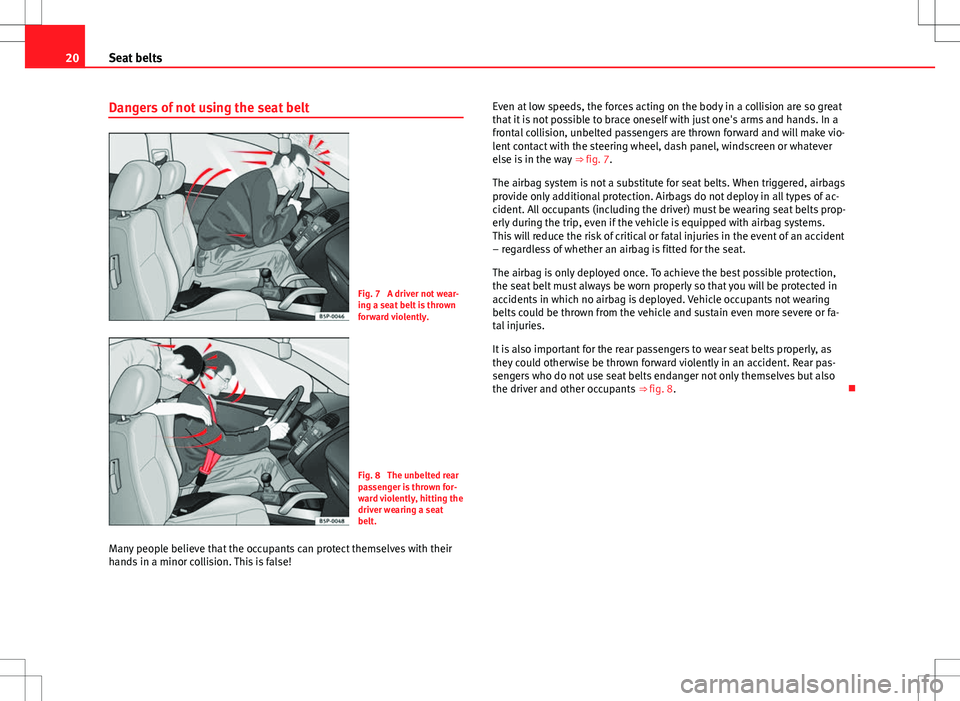
20Seat belts
Dangers of not using the seat belt
Fig. 7 A driver not wear-
ing a seat belt is thrown
forward violently.
Fig. 8 The unbelted rear
passenger is thrown for-
ward violently, hitting the
driver wearing a seat
belt.
Many people believe that the occupants can protect themselves with their
hands in a minor collision. This is false! Even at low speeds, the forces acting on the body in a collision are so great
that it is not possible to brace oneself with just one's arms and hands. In a
frontal collision, unbelted passengers are thrown forward and will make vio-
lent contact with the steering wheel, dash panel, windscreen or whatever
else is in the way
⇒ fig. 7.
The airbag system is not a substitute for seat belts. When triggered, airbags
provide only additional protection. Airbags do not deploy in all types of ac-
cident. All occupants (including the driver) must be wearing seat belts prop-
erly during the trip, even if the vehicle is equipped with airbag systems.
This will reduce the risk of critical or fatal injuries in the event of an accident
– regardless of whether an airbag is fitted for the seat.
The airbag is only deployed once. To achieve the best possible protection,
the seat belt must always be worn properly so that you will be protected in
accidents in which no airbag is deployed. Vehicle occupants not wearing
belts could be thrown from the vehicle and sustain even more severe or fa-
tal injuries.
It is also important for the rear passengers to wear seat belts properly, as
they could otherwise be thrown forward violently in an accident. Rear pas-
sengers who do not use seat belts endanger not only themselves but also
the driver and other occupants ⇒ fig. 8.
Page 23 of 388
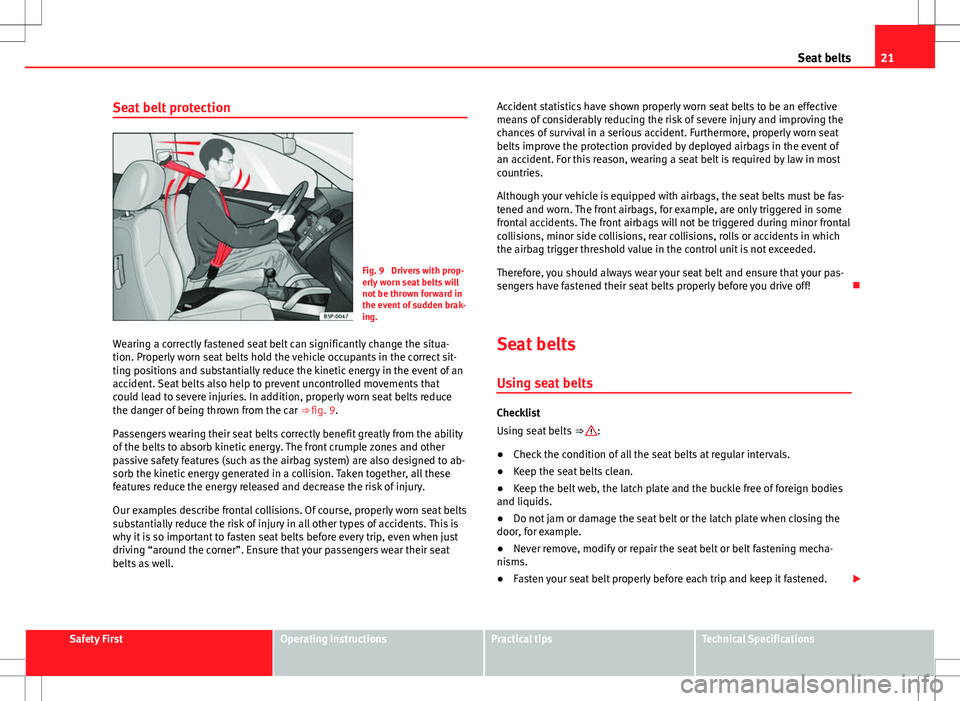
21
Seat belts
Seat belt protection
Fig. 9 Drivers with prop-
erly worn seat belts will
not be thrown forward in
the event of sudden brak-
ing.
Wearing a correctly fastened seat belt can significantly change the situa-
tion. Properly worn seat belts hold the vehicle occupants in the correct sit-
ting positions and substantially reduce the kinetic energy in the event of an
accident. Seat belts also help to prevent uncontrolled movements that
could lead to severe injuries. In addition, properly worn seat belts reduce
the danger of being thrown from the car ⇒ fig. 9.
Passengers wearing their seat belts correctly benefit greatly from the ability
of the belts to absorb kinetic energy. The front crumple zones and other
passive safety features (such as the airbag system) are also designed to ab-
sorb the kinetic energy generated in a collision. Taken together, all these
features reduce the energy released and decrease the risk of injury.
Our examples describe frontal collisions. Of course, properly worn seat belts
substantially reduce the risk of injury in all other types of accidents. This is
why it is so important to fasten seat belts before every trip, even when just
driving “around the corner”. Ensure that your passengers wear their seat
belts as well. Accident statistics have shown properly worn seat belts to be an effective
means of considerably reducing the risk of severe injury and improving the
chances of survival in a serious accident. Furthermore, properly worn seat
belts improve the protection provided by deployed airbags in the event of
an accident. For this reason, wearing a seat belt is required by law in most
countries.
Although your vehicle is equipped with airbags, the seat belts must be fas-
tened and worn. The front airbags, for example, are only triggered in some
frontal accidents. The front airbags will not be triggered during minor frontal
collisions, minor side collisions, rear collisions, rolls or accidents in which
the airbag trigger threshold value in the control unit is not exceeded.
Therefore, you should always wear your seat belt and ensure that your pas-
sengers have fastened their seat belts properly before you drive off!
Seat belts Using seat belts
Checklist
Using seat belts ⇒ :
● Check the condition of all the seat belts at regular intervals.
● Keep the seat belts clean.
● Keep the belt web, the latch plate and the buckle free of foreign bodies
and liquids.
● Do not jam or damage the seat belt or the latch plate when closing the
door, for example.
● Never remove, modify or repair the seat belt or belt fastening mecha-
nisms.
● Fasten your seat belt properly before each trip and keep it fastened.
Safety FirstOperating instructionsPractical tipsTechnical Specifications
Page 24 of 388
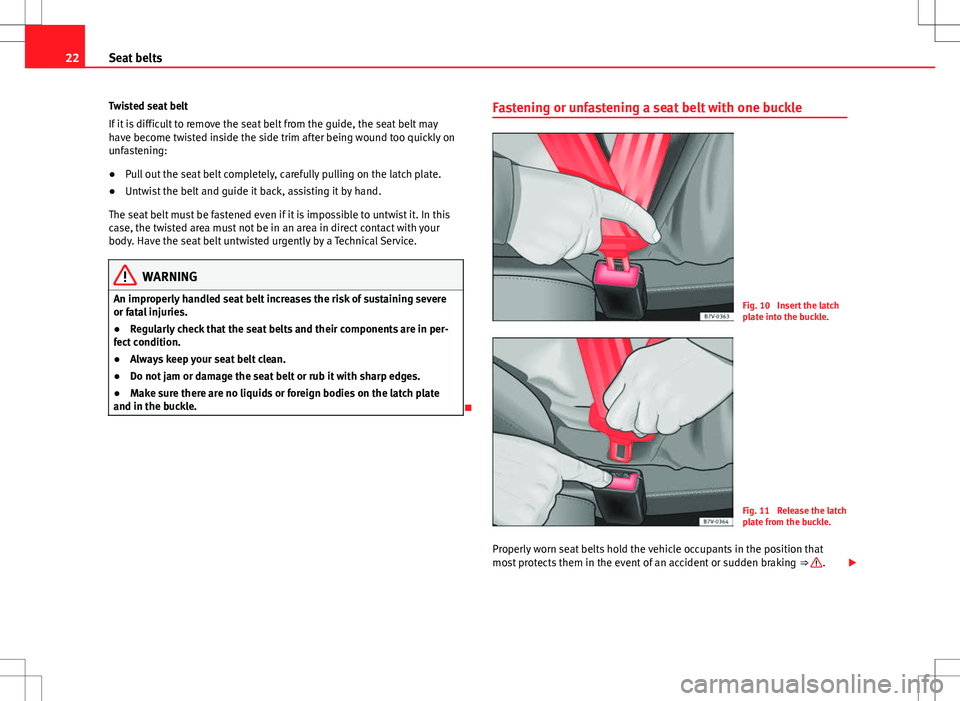
22Seat belts
Twisted seat belt
If it is difficult to remove the seat belt from the guide, the seat belt may
have become twisted inside the side trim after being wound too quickly on
unfastening:
● Pull out the seat belt completely, carefully pulling on the latch plate.
● Untwist the belt and guide it back, assisting it by hand.
The seat belt must be fastened even if it is impossible to untwist it. In this
case, the twisted area must not be in an area in direct contact with your
body. Have the seat belt untwisted urgently by a Technical Service.
WARNING
An improperly handled seat belt increases the risk of sustaining severe
or fatal injuries.
● Regularly check that the seat belts and their components are in per-
fect condition.
● Always keep your seat belt clean.
● Do not jam or damage the seat belt or rub it with sharp edges.
● Make sure there are no liquids or foreign bodies on the latch plate
and in the buckle.
Fastening or unfastening a seat belt with one buckle
Fig. 10 Insert the latch
plate into the buckle.
Fig. 11 Release the latch
plate from the buckle.
Properly worn seat belts hold the vehicle occupants in the position that
most protects them in the event of an accident or sudden braking ⇒
.
Page 25 of 388

23
Seat belts
Fastening the seat belt
Fasten your seat belt before each trip.
● Adjust the front seat and head restraint correctly ⇒ page 10.
● Engage the backrest of the rear seat in an upright position ⇒
.
● Pull the latch plate and place the belt webbing evenly across your chest
and lap. Do not twist the seat belt when doing so ⇒
.
● Engage the latch plate in the buckle of the corresponding seat ⇒ fig. 10.
● Pull the belt to ensure that the latch plate is securely engaged in the
buckle.
Unfastening the seat belt
The seat belt must not be unfastened until the vehicle has come to a stand-
still ⇒
.
● Press the red button on the buckle ⇒ fig. 11. The latch plate is released
from the buckle.
● Guide the belt back by hand so that it rolls up easily and the trim will not
be damaged.
WARNING
An incorrectly worn seat belt web can cause severe or fatal injuries in the
event of an accident.
● The seat belt cannot offer its full protection unless the backrests are
in an upright position and the seat belt is worn correctly, according to
your size.
● Unbuckling your seat belt while the vehicle is in motion can cause se-
vere or fatal injuries in the event of an accident or sudden braking.
Fastening or unfastening the seat belt with two buckles
Fig. 12 Fasten the seat
belt on the centre seat in
the second row of seats.
Properly worn seat belts hold the vehicle occupants in the position that
most protects them in the event of an accident or sudden braking ⇒
.
The seat belts for the centre seat in the second row of seats and for the
seats in the third row of seats are fastened using two buckles.
Fastening the seat belt
Fasten your seat belt before each trip.
● Adjust the rear seat and head restraint correctly ⇒ page 10.
● Engage the backrest of the rear seat in an upright position ⇒
.
● Use latch plate of the belt ⇒ fig. 12 1 to pull the seat belt down. Do
not
twist the seat belt when doing so ⇒ .
● Engage the latch plate 1 in the buckle of the corresponding seat A.
● Use the latch plate 2 to pull the seat belt across your lap.
● Engage the latch plate 2 in the buckle of the corresponding seat B.
● Pull the belt to ensure that both latch plates are securely engaged in the
buckles.
Safety FirstOperating instructionsPractical tipsTechnical Specifications
Page 26 of 388

24Seat belts
Unfastening the seat belt
The seat belt must not be unfastened until the vehicle has come to a stand-
still ⇒
.
● Press the red button on the buckle A
. The latch plate is released from
the buckle.
● Press the red button on the buckle B
. The latch plate is released from
the buckle.
● Guide the belt back by hand so that it rolls up easily and the trim will not
be damaged.
WARNING
An incorrectly worn seat belt web can cause severe or fatal injuries in the
event of an accident.
● The seat belt cannot offer its full protection unless the backrests are
in an upright position and the seat belt is worn correctly, according to
your size.
● Unbuckling your seat belt while the vehicle is in motion can cause se-
vere or fatal injuries in the event of an accident or sudden braking.
Note
Seat belts with two buckles include a diagram to show how to fasten the
seat belt.
Seat belt position
Fig. 13 Correct belt web and head restraint positions.
Page 27 of 388
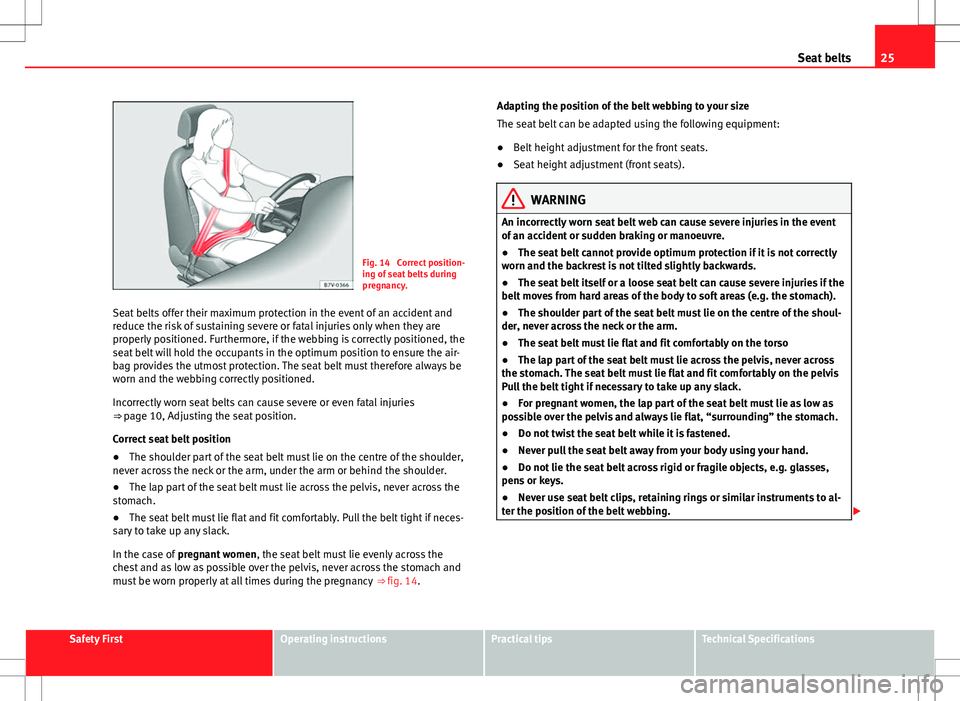
25
Seat belts
Fig. 14 Correct position-
ing of seat belts during
pregnancy.
Seat belts offer their maximum protection in the event of an accident and
reduce the risk of sustaining severe or fatal injuries only when they are
properly positioned. Furthermore, if the webbing is correctly positioned, the
seat belt will hold the occupants in the optimum position to ensure the air-
bag provides the utmost protection. The seat belt must therefore always be
worn and the webbing correctly positioned.
Incorrectly worn seat belts can cause severe or even fatal injuries
⇒ page 10, Adjusting the seat position.
Correct seat belt position
● The shoulder part of the seat belt must lie on the centre of the shoulder,
never across the neck or the arm, under the arm or behind the shoulder.
● The lap part of the seat belt must lie across the pelvis, never across the
stomach.
● The seat belt must lie flat and fit comfortably. Pull the belt tight if neces-
sary to take up any slack.
In the case of pregnant women , the seat belt must lie evenly across the
chest and as low as possible over the pelvis, never across the stomach and
must be worn properly at all times during the pregnancy ⇒ fig. 14.Adapting the position of the belt webbing to your size
The seat belt can be adapted using the following equipment:
●
Belt height adjustment for the front seats.
● Seat height adjustment (front seats).
WARNING
An incorrectly worn seat belt web can cause severe injuries in the event
of an accident or sudden braking or manoeuvre.
● The seat belt cannot provide optimum protection if it is not correctly
worn and the backrest is not tilted slightly backwards.
● The seat belt itself or a loose seat belt can cause severe injuries if the
belt moves from hard areas of the body to soft areas (e.g. the stomach).
● The shoulder part of the seat belt must lie on the centre of the shoul-
der, never across the neck or the arm.
● The seat belt must lie flat and fit comfortably on the torso
● The lap part of the seat belt must lie across the pelvis, never across
the stomach. The seat belt must lie flat and fit comfortably on the pelvis
Pull the belt tight if necessary to take up any slack.
● For pregnant women, the lap part of the seat belt must lie as low as
possible over the pelvis and always lie flat, “surrounding” the stomach.
● Do not twist the seat belt while it is fastened.
● Never pull the seat belt away from your body using your hand.
● Do not lie the seat belt across rigid or fragile objects, e.g. glasses,
pens or keys.
● Never use seat belt clips, retaining rings or similar instruments to al-
ter the position of the belt webbing.
Safety FirstOperating instructionsPractical tipsTechnical Specifications
Page 28 of 388
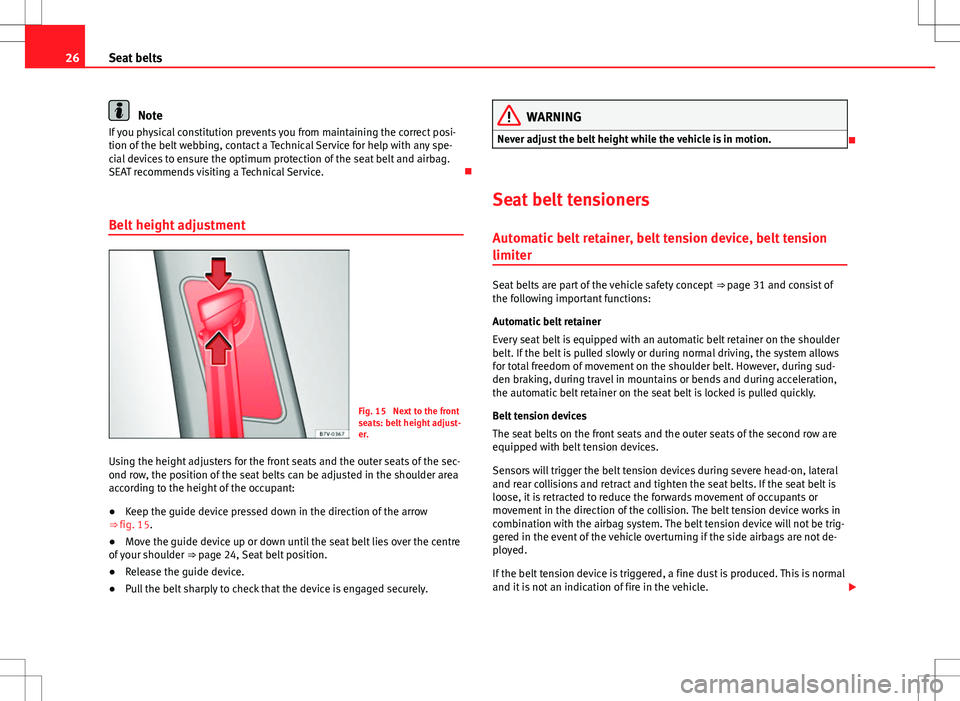
26Seat belts
Note
If you physical constitution prevents you from maintaining the correct posi-
tion of the belt webbing, contact a Technical Service for help with any spe-
cial devices to ensure the optimum protection of the seat belt and airbag.
SEAT recommends visiting a Technical Service.
Belt height adjustment
Fig. 15 Next to the front
seats: belt height adjust-
er.
Using the height adjusters for the front seats and the outer seats of the sec-
ond row, the position of the seat belts can be adjusted in the shoulder area
according to the height of the occupant:
● Keep the guide device pressed down in the direction of the arrow
⇒ fig. 15.
● Move the guide device up or down until the seat belt lies over the centre
of your shoulder ⇒ page 24, Seat belt position.
● Release the guide device.
● Pull the belt sharply to check that the device is engaged securely.
WARNING
Never adjust the belt height while the vehicle is in motion.
Seat belt tensioners
Automatic belt retainer, belt tension device, belt tension
limiter
Seat belts are part of the vehicle safety concept ⇒ page 31 and consist of
the following important functions:
Automatic belt retainer
Every seat belt is equipped with an automatic belt retainer on the shoulder
belt. If the belt is pulled slowly or during normal driving, the system allows
for total freedom of movement on the shoulder belt. However, during sud-
den braking, during travel in mountains or bends and during acceleration,
the automatic belt retainer on the seat belt is locked is pulled quickly.
Belt tension devices
The seat belts on the front seats and the outer seats of the second row are
equipped with belt tension devices.
Sensors will trigger the belt tension devices during severe head-on, lateral
and rear collisions and retract and tighten the seat belts. If the seat belt is
loose, it is retracted to reduce the forwards movement of occupants or
movement in the direction of the collision. The belt tension device works in
combination with the airbag system. The belt tension device will not be trig-
gered in the event of the vehicle overturning if the side airbags are not de-
ployed.
If the belt tension device is triggered, a fine dust is produced. This is normal
and it is not an indication of fire in the vehicle.
Page 29 of 388

27
Seat belts
Belt tension limiter
The belt tension limiter reduces the force of the seat belt on the body in the
event of an accident.
Note
The relevant safety requirements must be observed when the vehicle or
components of the system are scrapped. These requirements are known to
specialised workshops ⇒ page 27.
Service and disposal of belt tension devices
If you work on the belt tension devices or remove and install other parts of
the vehicle when performing other repair work, the seat belt may be dam-
aged. The consequence may be that, in the event of an accident, the belt
tension devices function incorrectly or not at all.
So that the effectiveness of the belt tension device is not reduced and that
removed parts do not cause any injuries or environmental pollution, regula-
tions must be observed. These requirements are known to qualified dealer-
ships.
WARNING
Improper handling and homemade repairs of seat belts, automatic belt
retainers and tension devices increase the risk of sustaining severe or fa-
tal injuries. The belt tension device may fail to trigger or may trigger in
the wrong circumstances.
● Never attempt to repair, adjust or remove or install parts of the belt
tension devices or seat belts. Any work must be performed by a Technical
Service only ⇒ page 261.
● Belt tension devices and automatic belt retainers cannot be repaired
and must be replaced.
For the sake of the environment
Airbag modules and belt tension devices may contain perchlorate. Observe
the legal requirements for their disposal.
Safety FirstOperating instructionsPractical tipsTechnical Specifications
Page 30 of 388
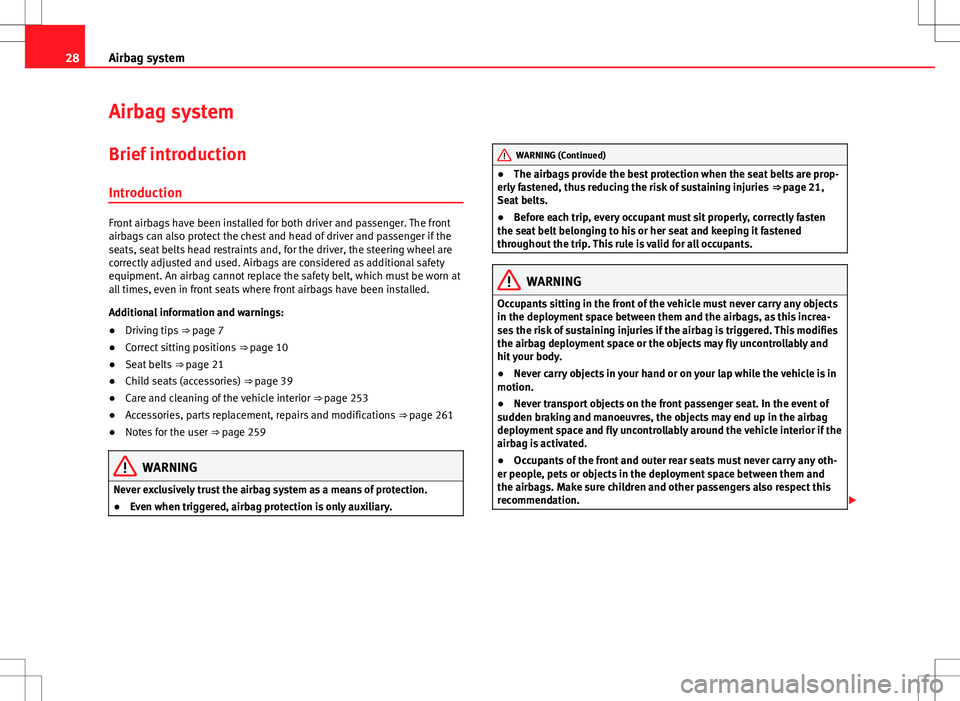
28Airbag system
Airbag system
Brief introduction Introduction
Front airbags have been installed for both driver and passenger. The front
airbags can also protect the chest and head of driver and passenger if the
seats, seat belts head restraints and, for the driver, the steering wheel are
correctly adjusted and used. Airbags are considered as additional safety
equipment. An airbag cannot replace the safety belt, which must be worn at
all times, even in front seats where front airbags have been installed.
Additional information and warnings:
● Driving tips ⇒ page 7
● Correct sitting positions ⇒ page 10
● Seat belts ⇒ page 21
● Child seats (accessories) ⇒ page 39
● Care and cleaning of the vehicle interior ⇒ page 253
● Accessories, parts replacement, repairs and modifications ⇒ page 261
● Notes for the user ⇒ page 259
WARNING
Never exclusively trust the airbag system as a means of protection.
● Even when triggered, airbag protection is only auxiliary.
WARNING (Continued)
● The airbags provide the best protection when the seat belts are prop-
erly fastened, thus reducing the risk of sustaining injuries ⇒ page 21,
Seat belts.
● Before each trip, every occupant must sit properly, correctly fasten
the seat belt belonging to his or her seat and keeping it fastened
throughout the trip. This rule is valid for all occupants.
WARNING
Occupants sitting in the front of the vehicle must never carry any objects
in the deployment space between them and the airbags, as this increa-
ses the risk of sustaining injuries if the airbag is triggered. This modifies
the airbag deployment space or the objects may fly uncontrollably and
hit your body.
● Never carry objects in your hand or on your lap while the vehicle is in
motion.
● Never transport objects on the front passenger seat. In the event of
sudden braking and manoeuvres, the objects may end up in the airbag
deployment space and fly uncontrollably around the vehicle interior if the
airbag is activated.
● Occupants of the front and outer rear seats must never carry any oth-
er people, pets or objects in the deployment space between them and
the airbags. Make sure children and other passengers also respect this
recommendation.